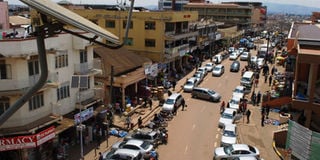
An aerial view of Mbarara City Main Street. Data from the Uganda Aids Commission shows that the city has a high HIV/Aids prevalence rate. PHOTO | RAJAB MUKOMBOZI
The recently released HIV/Aids report indicates that the disease prevalence in most districts in Ankole Sub-region is higher than the national rate of 5.1 percent.
Mbarara is leading the 13 districts of Ankole with 14 percent, followed by Kiruhura (9.5 percent), Bushenyi (9.2 percent), Mbarara City (8.1 percent) and Ibanda at 7.3 percent. Sheema is 7.5 percent, Rubirizi is 6.1 percent, and Ntungamo is 5.9 percent.
However, Mitooma has 4.7 percent, Buhweju 3.8 percent and Isingiro 3.1 percent.
The statistics from the Uganda Aids Commission (UAC) have raised concerns among residents and leaders.
Rwampara District chairperson Richard Owomugasho says people are living reckless lives.
“People are not bothered about their lives. For example in Nyeihanga, many people are sick because of the heavy trucks that park there. Women who are married or even not married are doing prostitution, which is very risky,” he says.
He calls for more community sensitisation, arguing that most people no longer consider HIV/Aids as a deadly disease.
His counterpart from Mbarara District, Mr Didas Tabaaro, attributes the high prevalence rate to stigma.
“People no longer see HIV as a big threat and because of the stigma around, most of them do not even go to seek medication one of my workers at the district died because of stigma,” he says.
Mr Tabaaro, however, says the statistics might not be accurate.
“They are branding our district as if everyone is sick. My technical teams are saying there could be a problem with the findings but nevertheless, we need to intensify efforts to fight the disease, especially in the urban centres,” he says.
Mr Lauben Tumwine, the chairperson of Rubaya Sub-county in Mbarara District, says the rate at which young girls hang out late in the night with men in small bars in rural trading centres is alarming.
“Young girls do not want the so-called dirty jobs and they move around with multiple men to enjoy life,” he says. Dr Julius Bamwine, the Ibanda District health officer, attributes the increase of HIV to prostitution.
“We have several young people, especially girls who come to these growing urban areas looking for jobs, the majority get employed in bars and end up in sex business to survive. Bar owners collect girls from some places to attract men and they will stay for a few months and then bring other girls, this exposes them to HIV,” he explains.
Dr Bamwine says also youth shun taking HIV drugs.
“The young people take medicine for the first time, then disappear, and others hide away from people while taking medication in fear of stigma so it becomes difficult to control the viral load,” he adds.
Mr Wilbroad Atukunzire, a counsellor under The Aids Support Organisation (TASO) at Ishongororo Health Centre IV, says behavioural management has been neglected.
“We need to target people, especially youth and intensify behavioural management because they are living in the most risky behaviours. We need to reach out to those who are sick and deliver messages for them to seek medication,’’ he explains.
Dr Ivan Kamya, the Kiruhura District health officer, says they have intensified efforts to contain the virus.
“We have extended our services to every sub-county, we supply condoms to the masses and we are doing a lot of sensitisation, I think where we are now is better than 10 years back ,” he notes.
The coordinator of people living with HIV in Mbarara City, Ms Joyce Tibaijuka, says there is lack of comprehensive knowledge among young people.
“Despite investment in HIV prevention and treatment, comprehensive knowledge among young people is still very low due to the high illiteracy levels among young adults and middle-aged,” she says.
Risk factors
Last month during a media engagement in Mbarara, Dr Steve Asiimwe, a researcher with Uganda Aids Commission, noted that HIV is increasing among girls because of the vulnerabilities they face. “Girls and women suffer gender-based violence, engage in sex work and are victims of sex-related crimes,” he noted.
By Rajab Mukombozi, Jovita Kyarisiima, Cosline Nakahiira & Felix Ainebyoona




